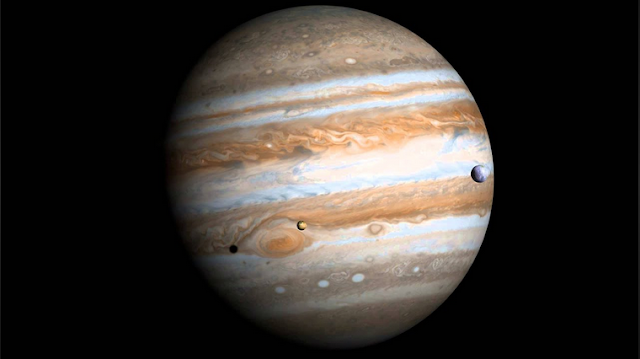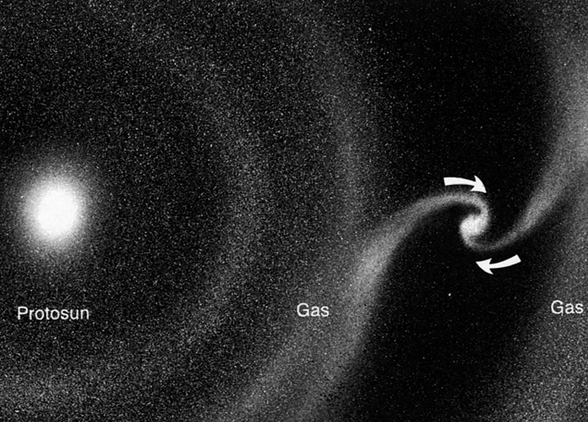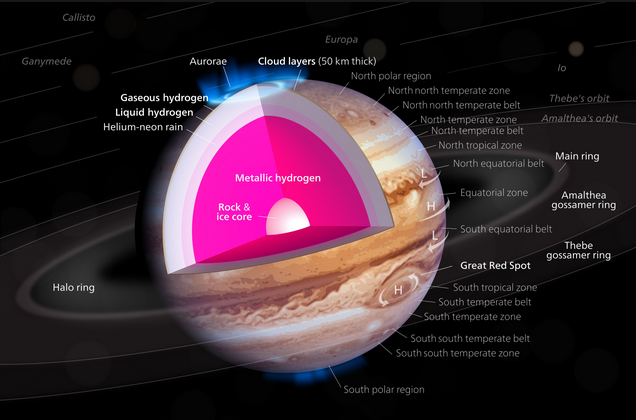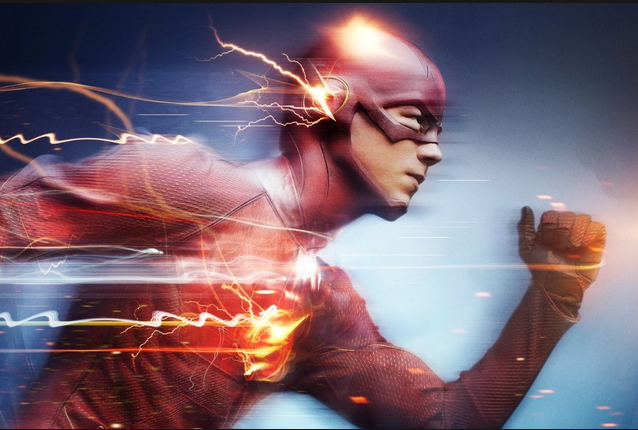Jupiter
The largest planet of all, Jupiter is more than twice as all the planets combined. Unlike rocky worlds, such as Earth or Mars, Jupiter is a gas giant- a vast, spinning globe of gas and liquid with no solid surface.

It is the fifth planet from the Sun and the largest in the Solar System. It is a gas giant with a mass one-thousandth that of the Sun, but two-and-a-half times that of all the other planets in the Solar System combined. Jupiter is one of the brightest objects visible to the naked eye in the night sky, and has been known to ancient civilizations since before recorded history. It is named after the Roman god Jupiter. When viewed from Earth, Jupiter can be bright enough for its reflected light to cast shadows, and is on average the third-brightest natural object in the night sky after the Moon and Venus.
Jupiter is primarily composed of hydrogen with a quarter of its mass being helium, though helium comprises only about a tenth of the number of molecules. It may also have a rocky core of heavier elements, but like the other giant planets, Jupiter lacks a well-defined solid surface. Because of its rapid rotation, the planet's shape is that of an oblate spheroid (it has a slight but noticeable bulge around the equator). The outer atmosphere is visibly segregated into several bands at different latitudes, resulting in turbulence and storms along their interacting boundaries. A prominent result is the Great Red Spot, a giant storm that is known to have existed since at least the 17th century when it was first seen by telescope. Surrounding Jupiter is a faint planetary ring system and a powerful magnetosphere. Jupiter has 79 known moons, including the four large Galilean moons discovered by Galileo Galilei in 1610. Ganymede, the largest of these, has a diameter greater than that of the planet Mercury.
Pioneer 10 was the first spacecraft to visit Jupiter, making its closest approach to the planet on December 4, 1973; Pioneer 10 identified plasma in Jupiter's magnetic field and also found that Jupiter's magnetic tail was nearly 800 million kilometers long, covering the entire distance to Saturn. Jupiter has been explored on a number of occasions by robotic spacecraft, beginning with the Pioneer and Voyager flyby missions from 1973 to 1979, and later by the Galileo orbiter, which arrived at Jupiter in 1995. In late February 2007, Jupiter was visited by the New Horizons probe, which used Jupiter's gravity to increase its speed and bend its trajectory en route to Pluto. The latest probe to visit the planet is Juno, which entered into orbit around Jupiter on July 4, 2016. Future targets for exploration in the Jupiter system include the probable ice-covered liquid ocean of its moon EuropaPhysical Characteristics
Jupiter's upper atmosphere is about 88–92% hydrogen and 8–12% helium by percent volume of gas molecules. A helium atom has about four times as much mass as a hydrogen atom, so the composition changes when described as the proportion of mass contributed by different atoms. Thus, Jupiter's atmosphere is approximately 75% hydrogen and 24% helium by mass, with the remaining one percent of the mass consisting of other elements. The atmosphere contains trace amounts of methane, water vapor, ammonia, and silicon-based compounds. There are also traces of carbon, ethane, hydrogen sulfide, neon, oxygen, phosphine, and sulfur. The outermost layer of the atmosphere contains crystals of frozen ammonia. Through infrared and ultraviolet measurements, trace amounts of benzene and other hydrocarbons have also been found. The interior contains denser materials—by mass it is roughly 71% hydrogen, 24% helium, and 5% other elements.
The atmospheric proportions of hydrogen and helium are close to the theoretical composition of the primordial solar nebula. Neon in the upper atmosphere only consists of 20 parts per million by mass, which is about a tenth as abundant as in the Sun. Helium is also depleted to about 80% of the Sun's helium composition. This depletion is a result of precipitation of these elements into the interior of the planet.
Based on spectroscopy, Saturn is thought to be similar in composition to Jupiter, but the other giant planets Uranus and Neptune have relatively less hydrogen and helium and relatively more ices and are thus now termed ice giants.
Mass and Size
Theoretical models indicate that if Jupiter had much more mass than it does at present, it would shrink. For small changes in mass, the radius would not change appreciably, and above about 500 (1.6 Jupiter masses) the interior would become so much more compressed under the increased pressure that its volume would decrease despite the increasing amount of matter. As a result, Jupiter is thought to have about as large a diameter as a planet of its composition and evolutionary history can achieve. The process of further shrinkage with increasing mass would continue until appreciable stellar ignition was achieved, as in high-mass brown dwarfs having around 50 Jupiter masses.
Although Jupiter would need to be about 75 times as massive to fuse hydrogen and become a star, the smallest red dwarf is only about 30 percent larger in radius than Jupiter. Despite this, Jupiter still radiates more heat than it receives from the Sun; the amount of heat produced inside it is similar to the total solar radiation it receives.This additional heat is generated by the Kelvin–Helmholtz mechanism through contraction. This process causes Jupiter to shrink by about 2 cm each year.When it was first formed, Jupiter was much hotter and was about twice its current diameter.
Jupiter was expected to either consist of a dense core, a surrounding layer of liquid metallic hydrogen (with some helium) extending outward to about 78% of the radius of the planet, and an outer atmosphere consisting predominantly of molecular hydrogen, or perhaps to have no core at all, consisting instead of denser and denser fluid (predominantly molecular and metallic hydrogen) all the way to the center, depending on whether the planet accreted first as a solid body or collapsed directly from the gaseous protoplanetary disk. However, the Juno mission, which arrived in July 2016, found that Jupiter has a very diffuse core, mixed into the mantle. A possible cause is an impact from a planet of about ten Earth masses a few million years after Jupiter's formation, which would have disrupted an originally solid Jovian core.
Above the layer of metallic hydrogen lies a transparent interior atmosphere of hydrogen. At this depth, the pressure and temperature are above hydrogen's critical pressure of 1.2858 MPa and critical temperature of only 32.938 K. In this state, there are no distinct liquid and gas phases—hydrogen is said to be in a supercritical fluid state. It is convenient to treat hydrogen as gas extending downward from the cloud layer to a depth of about 1,000 km, and as liquid in deeper layers. Physically, there is no clear boundary—the gas smoothly becomes hotter and denser as one descends. Rain-like droplets of helium and neon precipitate downward through the lower atmosphere, depleting the abundance of these elements in the upper atmosphere. Rainfalls of extraterrestrial diamonds have been suggested to occur, as well as on Saturn and the ice giants Uranus and Neptune.
The temperature and pressure inside Jupiter increase steadily inward, due to the Kelvin–Helmholtz mechanism. At the pressure level of 10 bars (1 MPa), the temperature is around 340 K (67 °C; 152 °F). At the phase transition region where hydrogen—heated beyond its critical point—becomes metallic, it is calculated the temperature is 10,000 K (9,700 °C; 17,500 °F) and the pressure is 200 GPa. The temperature at the core boundary is estimated to be 36,000 K (35,700 °C; 64,300 °F) and the interior pressure is roughly 3,000–4,500 GPa.
Atmosphere
Jupiter is perpetually covered with clouds composed of ammonia crystals and possibly ammonium hydrosulfide. The clouds are located in the tropopause and are arranged into bands of different latitudes, known as tropical regions. These are sub-divided into lighter-hued zones and darker belts. The interactions of these conflicting circulation patterns cause storms and turbulence. Wind speeds of 100 m/s (360 km/h) are common in zonal jets. The zones have been observed to vary in width, color and intensity from year to year, but they have remained sufficiently stable for scientists to give them identifying designations.
The cloud layer is only about 50 km (31 mi) deep, and consists of at least two decks of clouds: a thick lower deck and a thin clearer region. There may also be a thin layer of water clouds underlying the ammonia layer. Supporting the idea of water clouds are the flashes of lightning detected in the atmosphere of Jupiter. These electrical discharges can be up to a thousand times as powerful as lightning on Earth. The water clouds are assumed to generate thunderstorms in the same way as terrestrial thunderstorms, driven by the heat rising from the interior.
The orange and brown coloration in the clouds of Jupiter are caused by upwelling compounds that change color when they are exposed to ultraviolet light from the Sun. The exact makeup remains uncertain, but the substances are thought to be phosphorus, sulfur or possibly hydrocarbons.These colorful compounds, known as chromophores, mix with the warmer, lower deck of clouds. The zones are formed when rising convection cells form crystallizing ammonia that masks out these lower clouds from view.
Jupiter's low axial tilt means that the poles constantly receive less solar radiation than at the planet's equatorial region. Convection within the interior of the planet transports more energy to the poles, balancing out the temperatures at the cloud layer.
Observation
Jupiter is usually the fourth brightest object in the sky (after the Sun, the Moon and Venus); at times Mars is brighter than Jupiter. Depending on Jupiter's position with respect to the Earth, it can vary in visual magnitude from as bright as −2.94 at opposition down to −1.66 during conjunction with the Sun. The mean apparent magnitude is −2.20 with a standard deviation of 0.33. The angular diameter of Jupiter likewise varies from 50.1 to 29.8 arc seconds. Favorable oppositions occur when Jupiter is passing through perihelion, an event that occurs once per orbit.
Earth overtakes Jupiter every 398.9 days as it orbits the Sun, a duration called the synodic period. As it does so, Jupiter appears to undergo retrograde motion with respect to the background stars. That is, for a period Jupiter seems to move backward in the night sky, performing a looping motion.
Because the orbit of Jupiter is outside that of Earth, the phase angle of Jupiter as viewed from Earth never exceeds 11.5°: Jupiter always appears nearly fully illuminated when viewed through Earth-based telescopes. It was only during spacecraft missions to Jupiter that crescent views of the planet were obtained. A small telescope will usually show Jupiter's four Galilean moons and the prominent cloud belts across Jupiter's atmosphere. A large telescope will show Jupiter's Great Red Spot when it faces Earth.













Comments
Post a Comment